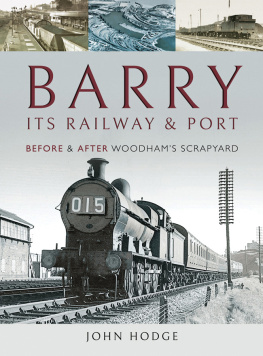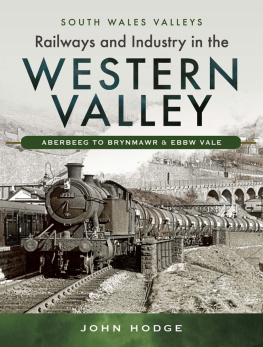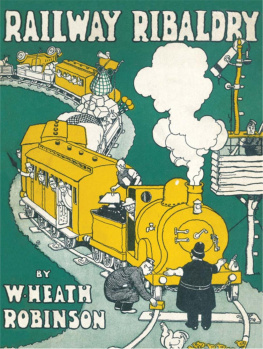Hodge John - Barry, Its Railway and Port
Here you can read online Hodge John - Barry, Its Railway and Port full text of the book (entire story) in english for free. Download pdf and epub, get meaning, cover and reviews about this ebook. year: 2018, publisher: Pen & Sword Books, genre: Home and family. Description of the work, (preface) as well as reviews are available. Best literature library LitArk.com created for fans of good reading and offers a wide selection of genres:
Romance novel
Science fiction
Adventure
Detective
Science
History
Home and family
Prose
Art
Politics
Computer
Non-fiction
Religion
Business
Children
Humor
Choose a favorite category and find really read worthwhile books. Enjoy immersion in the world of imagination, feel the emotions of the characters or learn something new for yourself, make an fascinating discovery.
- Book:Barry, Its Railway and Port
- Author:
- Publisher:Pen & Sword Books
- Genre:
- Year:2018
- Rating:3 / 5
- Favourites:Add to favourites
- Your mark:
- 60
- 1
- 2
- 3
- 4
- 5
Barry, Its Railway and Port: summary, description and annotation
We offer to read an annotation, description, summary or preface (depends on what the author of the book "Barry, Its Railway and Port" wrote himself). If you haven't found the necessary information about the book — write in the comments, we will try to find it.
Barry, Its Railway and Port — read online for free the complete book (whole text) full work
Below is the text of the book, divided by pages. System saving the place of the last page read, allows you to conveniently read the book "Barry, Its Railway and Port" online for free, without having to search again every time where you left off. Put a bookmark, and you can go to the page where you finished reading at any time.
Font size:
Interval:
Bookmark:


FRONT COVER: On Summer Sundays and Bank Holidays an excursion ran from the Sirhowy Valley to Barry Island, dating back to the early years of the century. In the 1950s, the down train arrived around midday and returned at 7.35pm, hauled by a former London & North Western 0-8-0 which turned on the Dock at Barry. Here we see Tredegars 49064 with the return train on 26th May 1958, the last year of former LNW haulage, passing Cadoxton Low Level Signal Box, before joining the former Barry Main Line via Wenvoe.
TITLE PAGE: An everyday scene at No. 1 Dock as a small coaster awaits loading at No. 1 Tip where a vessel is currently loading. The view is from the point at which the passenger ferry operated carrying the public across the Dock to near the C.H. Bailey Dry Dock from where they could walk to either Jacksons Bay or Barry Island. The ferry was first provided for workmen but was later made available to the public and was very well used.
BACK COVER: A panoramic view from Ship Hill Bridge of the modern scene at Barry station as a Pacer leaves with the 10.5am to Bridgend in October 2016. M.J. Back.

First published in Great Britain in 2018 by
Pen & Sword Transport
An imprint of
Pen & Sword Books Ltd
Yorkshire - Philadelphia
Copyright John Hodge, 2018
ISBN 978 1 52672 3 833
eISBN 978 1 52672 3 840
Mobi ISBN 978 1 52672 3 857
The right of John Hodge to be identified as Author of this work has been asserted by them in accordance with the Copyright, Designs and Patents Act 1988.
A CIP catalogue record for this book is available from the British Library
All rights reserved. No part of this book may be reproduced or transmitted in any form or by any means, electronic or mechanical including photocopying, recording or by any information storage and retrieval system, without permission from the Publisher in writing.
Pen & Sword Books Ltd incorporates the Imprints of Aviation, Atlas, Family History, Fiction, Maritime, Military, Discovery, Politics, History, Archaeology, Select, Wharncliffe Local History, Wharncliffe True Crime, Military Classics, Wharncliffe Transport, Leo Cooper, The Praetorian Press, Remember When, Seaforth Publishing and Frontline Publishing.
For a complete list of Pen & Sword titles please contact
PEN & SWORD BOOKS LTD
47 Church Street, Barnsley, South Yorkshire, S70 2AS, England
E-mail:
Website: www.pen-and-sword.co.uk
Or
PEN AND SWORD BOOKS
1950 Lawrence Rd, Havertown, PA 19083, USA
E-mail:
Website: www.penandswordbooks.com
I DEDICATE THIS book to those who educated me at Barry Grammar School which I attended from 1948 to 1956. What a wonderful array of highly professional masters there were during that period and before. My main dealings were with the following to whom I am ever grateful for their expertise: Griffith Caradoc Hughes (French); Teifion Phillips (History); Percy Fisher (English); Eric Jones (Maths); Gwyn Thomas (Spanish); Bryn Ashton (Latin); Digby Lloyd (Physics); Sidney Perkins (Chemistry) and many others, each of whom had his personal nickname. Unfortunately, the history curriculum contained no reference to local history, so when I left I knew nothing about the development of the Docks from 1884, or the Barry Railway, a significant omission to my education which I have had to rectify since.
IN MY RESEARCH, I have used Martin J. Becketts excellent little book The Barry Story , published in 1982, mostly for details of the number of engines bought for scrapping by Woodhams and their ultimate fate.
SOME READERS WILL only have heard of Barry in connection with the Scrapyard run by Dai Woodham during the 1960s and 70s, from which most of the engines were bought and restored to run on our heritage railways. But the railways and docks at Barry have a complete history all of their own which had achieved huge importance and fascination well before the Scrapyard ever existed. This book sets out to describe the Docks and Railway development and activities before and after the Scrapyard years with short sections on each aspect.
I lived at Barry for twenty-eight years from 1942 to 1970 and, though only young, saw some of the wartime activity at the Docks. Much of the comment relative to this period stems from my own experience and recollection. Almost all the photographs are from my own collection, both during the above period and on my visits since, but I have also used images by J.G. Hubback, whose collection I acquired in the late 1950s, some modern images by my friend Michael J. (Mike) Back of Efail Isaf, plus a few images bought in. Where no credit appears, these are photos taken by me or from my own collection.
MY FAMILY MOVED to Barry from Crosskeys, in the Western Valley, in 1942, when I was coming up to the ripe old age of four, and we soon moved to a house in Dock View Road, near the Sea View Labour Club, which overlooked a fantastic panorama of transport. Across the road, allotments ran from one end of the road to the other, about six to ten feet below road level as the road climbed and fell. Below this was a steep bank about twenty to thirty feet down, below which was the main line from Barry Docks to Cadoxton, and a few feet below this was the line into the Docks from Cadoxton Low Level, four tracks, two into the Old (No. 1) Dock, and two into the New (No. 2) Dock, both entering tunnels right in front of our house. Above the tunnels and on the same level as the main line was Barry Docks Storage Sidings, where thousands of coal wagons, loaded and empty, were marshalled for shipment and return empty to the collieries. Some general freight was also marshalled in these sidings. Beyond the marshalling yard were the tracks leading to the coal hoists where coal wagons were tipped into the ships berthed at the hoists on the north side of No. 2 Dock.
On the south side of the Dock was Ranks Flour Mill, where incoming ships would unload their cargo for processing and later at the south-west end of the Dock was the berth for the Geest Banana Traffic which became the main traffic, other than coal, from the mid-1950s until the company departed for Southampton in the mid-1960s. On the north side of the dock were ten coal hoists or tips, where coal wagons were unloaded into the ships berthed below them, five tips being removed in the late 1950s to be replaced by high capacity cranes for the import of bulk cargoes. Beyond the docks lay the Bristol Channel where vessels for Barry Docks would lie at anchor in Barry Roads until their tidal time arrived for entry, and pilot boats and tugs would ply between them to arrange their passage into the docks, if this was necessary. In the days after the war, the public could walk freely through the docks, and there was even a ferry service across No. 1 Dock to take passengers from just below the Dock Offices on the north side across to the bottom of Battery Hill, near the C.H. Bailey Dry Dock, on the south side from where they could walk either to Jacksons Bay or to Barry Island.

Font size:
Interval:
Bookmark:
Similar books «Barry, Its Railway and Port»
Look at similar books to Barry, Its Railway and Port. We have selected literature similar in name and meaning in the hope of providing readers with more options to find new, interesting, not yet read works.
Discussion, reviews of the book Barry, Its Railway and Port and just readers' own opinions. Leave your comments, write what you think about the work, its meaning or the main characters. Specify what exactly you liked and what you didn't like, and why you think so.













